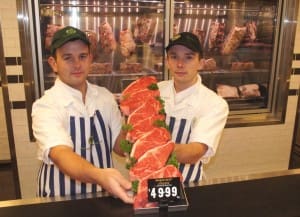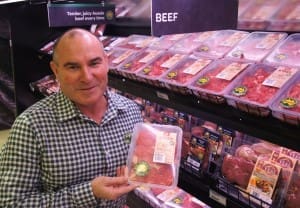Tag along with Pat McEntee, Woolworths’ general manager of supermarket operations during a store visit, and it quickly becomes evident that there’s a retail butcher lurking not far beneath the surface.
Mr McEntee cut his teeth with the nation’s largest supermarket retailer as an apprentice butcher in the company’s Camden store 30 years or more ago, before working his way up through the ranks in a classic ‘bottom to the top’ career trajectory.
Beef Central spent time with him during a recent store visit to the company’s impressive new flagship Indooroopilly (Queensland) outlet.
He prowls the store’s meat department, straightening a pre-pack here; commenting on cutting lines and presentation in a window display there. Here is a high-flying national retail supermarket executive who has an unusually deep and fundamental understanding of the red meat space, and more importantly, what hits consumers’ buttons when shopping for meat protein.
His choice of Indooroopilly for our meeting was not without significance.
The recently-opened site, in the greatly-expanded Indooroopilly Shopping Centre in Brisbane’s inner west, has features unseen in most supermarkets in Australia.
Indooroopilly bristles with a host of unique features which may provide some portent to the future trends in supermarket retailing, and for beef in particular.
Just some of the unusual features:
- A full-service high-end butchery with a display of freshly cut red and white meat protein to rival any of the best independent butcheries in Brisbane. The ‘butcher shop’ sits right beside the store’s traditional self-serve chilled cabinets where supermarket shoppers make their own meat choices. About 12 or 14 Woolworths stores across Australia have been fitted with the ‘butchery shop’ facility, complete with dedicated staff
- Previously unseen supermarket beef products, like highly-marbled Wagyu steaks offered under independent brand programs like AA Co’s Darling Downs Wagyu.
- A well-stocked, dry-aging display cabinet, similar to those seen in some of Australia’s ultra-premium butcher shops and steakhouses.
- Up to seven different variations on the same beef cut. Sirloin steaks, for example, were seen in Indooroopilly in Certified Organic, conventional, budget, 100-day grainfed (Gold), Riverine, PCAS grassfed and Wagyu forms.
It’s features like these that provide some cues to where Woolworths might be heading in its retail beef offer, across close to 900 stores, nationwide.
“Indooroopilly is a really important store for us here in Queensland,” Mr McEntee told Beef Central.
“It’s always been one of our flagship stores within our fleet, and somewhere we feel comfortable trialling and developing new concepts and ideas,” he said.
Greater engagement with customers
“We’ve had butchers in our stores for as long as Woolworths has been selling meat, but in the past we’ve tended to have them working behind solid walls, out of sight of the customers.”
“This new full service butchery feature is, instead, all about putting the butcher directly in touch with the customer, engaging with them and answering questions about suitability for purpose or other issues. Customers are so much more inquisitive today,” he said.
“There’s certainly a higher labour requirement with a full service butchery in a shop like this, but at the end of the day we get out of bed every day to serve our customers, and presenting a beautiful display like that at Indooroopilly is part of that process.”
Woolies is putting considerable time and effort across the business into stimulating greater engagement between staff and customers. “We’re talking with our teams right across Australia about how each store connects with our customers. That’s about how our staff can take time, through their day, to slow down just a little, to engage, interact and connect more with shoppers.”
That goes against the basic conventions of modern of ‘self-service’ retailing, and means a higher staff requirement, but it delivers that important connection with customers that Woolworths increasingly sees as important.
In research, customers were saying Woolworths’ our staff were really friendly, but they were too busy to be of assistance. The company listed to that, and has done something about it, with a program now in place called “My Five Minutes” where staff take the time out of their busy day for customer engagement.
In large format stores like Indooroopilly, Woolies also employs what it calls ‘foodies’ – full-time staff with a chef background and strong food knowledge, specifically for the engagement role in the fresh food area (meat and produce). Part of their work is preparing and offering seasonal product samples, as well as talking with customers.
Dry aged beef

Indooroopilly butchery staff Nathan Laughton and Matt O’ Sullivan with Wagyu strips at $50/kg, and dry aging cabinet at rear
One of the most obvious features which sets Indooroopilly’s beef offer apart from virtually every other supermarket in Australia is the addition of a dry-aging cabinet, well-stocked with whole primals and showcased for the customer.
“We’re very happy with what we’re doing in our dry-aged beef line,” Mr McEntee said.
“Woolies has always sold great meat, and we’re very proud of our young, grainfed/grassfed beef offer that we sell under the MSA system. But occasionally people want something different, and we think dry-aging does two things for us: it certainly lifts the customers’ overall perception of the great quality meat we have, highlighting our meat credentials and expertise; but there is also greater demand today among customers to experiment with what they’re eating at home, and dry-aging is a part of that.”
“Woolies now is not only a great place to come and buy everyday product, but also a special occasion product like this dry-aged beef,” he said.
“It’s about giving customers what they want, and perhaps giving customers access to that high-end product like dry-aged or highly-marbled Wagyu, that we didn’t specialise in before.”
Dry age windows and full service butcheries won’t appear in every shop across Australia, but the company plans to pick targets, and where appropriate, will do more like this.
“We’re learning more about customers’ requirements, in certain locations, where demand for products can vary. Not every one of the 929 supermarkets from Darwin to Hobart will stock the same items. Goatmeat, for example, is selling particularly well in some locations – unheard of only a short time ago – but it might not sell so well in others.”
Greater range
All of the features above means greater diversity of product range, in the red meat space.
In some stores, Woolworths’ beef product offer was probably 25 to 30 percent more diverse than it was a few years ago, Mr McEntee said.
“But that’s what customers increasingly expect from us. What we need to do, on a daily basis, is ask ourselves whether a) we are providing the value customers are looking for, which remains critically important, and b) whether we’re offering the depth of range and types of products that customers want to experiment with, or use more frequently, enjoyed at home with their families.”
Part of that included the launch recently of a certified pasturefed beef offer, under the PCAS Pasturefed Cattle Assurance System (see Beef Central’s earlier article).
The fact that some stores may stock, five or six different sirloins (as discussed above), was all about how well educated many customers were these days, Mr McEntee said.
“Certainly many customers who take the time to understand the different beef products will navigate the variety of offers quite easily – a 350-day grainfed Wagyu steak or a 100-day Riverine product for example. For others, it will be part of the experimentation process that many consumers are now interested in.”
“Social media, internet and other digital platforms are driving that, as are TV food programs. All of the information necessary to make the right judgements in such selections is just so accessible to consumers today,” he said.
Packaging plays big role
One of the developments that has allowed Woolworths to broaden its product range so much has been packaging innovation, providing greater shelf-life and less waste.
Mr McEntee said it would be much harder to pursue such strategies simply using cling-film wrapped trays of chilled meat.
“It would be really difficulty to manage within the store environment, but many of the new packaging options will give a week or ten days shelf-life on the same item, rather than a day or two,” he said.
Apart from the full-service butchery area, the overwhelming majority of Woolworths Indooroopilly’s chilled meat offer now is Dar-Fresh, Modified Atmosphere (MAP) packaged, or cryovac, with very little traditional tray and cling film.
“One piece of feedback we always have from customers in meat is the leakage issue. The technology we have today, whether its MAP-pack, cryovac or others, eliminates this. No customer wants to pick up a tray of meat, only for it to leak over other items in the trolley, or worse still, in the car on the way home.”
“This is very much about the customer, making it easier, more convenient, and overcoming problems like drip and leakage.”
Ever-greater emphasis on value-added is also part of this convenience factor.
“They key to selling protein in Australia is that it is seasonal. We all eat differently at home in winter than we do in summer, so it is about having easy, convenient value-added products out there that appeal to customers, on many levels.”
“Anything we can do to excite the customer, giving them something new in terms of cuts or flavours, variety or preparations, is just helping mums at home, and making life easier for them.”
“It’s an evolutionary thing. I don’t think we’ve gone close to tapping the bottom of the well on value-added. It will continue indefinitely, and has been hugely successful for us,” Mr McEntee said.
“We read Beef Central’s trade reports constantly, and it accurately reports Woolworths’ domestic retail beef market share. We are continuing to grow out market share, and value-added is a key part of that, there’s no doubt.”
But other attributes like MSA have also played a big role for Woolworths.
“Undoubtedly, what MSA has done is to further improve the consistency of tenderness of our beef. We know that, our customers know that, and it is directly reflected in the industry information we all look at. Having that objective MSA measure to underpin the great quality meat that Woolworths has is a big asset,” he said.



